Ambulance crews are instructed to dump seriously ill patients in hospital corridors when there are no emergency doctors nearby
Ambulance staff have been instructed to leave seriously ill patients in hospital corridors if they have to wait longer than 45 minutes before being handed over to emergency medical teams.
The move would allow patients to be dumped without being admitted, in an effort to reduce delays in life-threatening emergencies.
NHS England has claimed that this new ‘drop and go’ approach would free up paramedics so they could respond more quickly to 999 calls.
Care Minister Stephen Kinnock claimed the policy was being rolled out because it had ‘worked really well’ in London.
Yet emergency doctors today criticized the measure, warning that it could ‘endanger the lives of patients’.
Ambulance staff have been told to leave patients in hospital corridors if they wait longer than 45 minutes (stock image)

London ambulances began testing a policy where ambulance crews did not wait for the hospital to be ready to admit a new patient, but instead informed a nurse that they would be leaving after 45 minutes. In these cases, patients were left on carts in hallways and emergency room waiting rooms to be seen (stock image)
Speaking on Times Radio this morning, Mr Kinnock said: ‘There are examples of systems that work, of reforms that have been effective.
“We shouldn’t just close our ears to that, we should look at it and if we can make it work in a different setting, then we should be open to that.”
He also said on LBC that, thanks to the ‘drop and go’ approach, emergency services bosses have managed to get ambulances back to treating urgent issues more quickly.
The aim is for paramedics to take less than 15 minutes to transfer patients to hospital staff.
But often overwhelmed hospitals struggle to find time or even beds for new patients.
These delays in admitting patients are one of the reasons why response times for category two calls, such as heart attacks and strokes, exceeded an hour and a half last January, when they should have been responded to within 18 minutes.
To tackle the problem, London ambulances began testing a policy where crews notified a nurse that they would leave after 45 minutes if no transmission had occurred.
In these cases, patients were left on carts in hallways and emergency room waiting rooms.

London isn’t the only area changing how patients are transferred. South Central Ambulance Service this year started the ‘fit to sit’ system, where patients with less serious injuries self-attend to A&E (stock image)
This scheme has reportedly been a success in the capital, with response times now down to half an hour, and NHS England has started advising services in other parts of the country to adopt London’s scheme.
Daniel Elkeles, chief executive of the London Ambulance Service, explained that before the introduction of the ‘drop and go’ policy, they regularly lost up to 600 hours of time every day waiting to hand over patients.
But Adrian Boyle, president of the Royal College of Emergency Medicine, says it is ‘not acceptable’ to leave sick and injured patients without proper handover.
He added that A&E doctors understand the need for ambulances to return to the front line as quickly as possible, but said delays were a symptom of wider pressure from the NHS.
Many doctors outside London are also against the measure.
Dr. Rachel Clarke, a palliative care doctor from Oxford, wrote of
“This does not solve the problem, it is a passing of the bill, putting unbearable pressure on my emergency department colleagues, putting the lives of patients stranded on the corridors at risk.”
Plymouth emergency doctor Ian Higginson also wrote on X, adding that the policy ‘won’t solve anything’.
He said: ‘The ambulance drop-and-go policy will not solve anything in the long term and will hide the lack of meaningful action. Hundreds of patients die every week due to overcrowding in emergency departments. How about solving the actual problem?’
London isn’t the only area changing how patients are transferred. South Central Ambulance Service started the ‘fit to sit’ system this year, where patients with less serious injuries self-report to A&E.
A spokeswoman for NHS England said the policy had helped London speed up response times and that the NHS was ‘constantly looking for safe and effective ways to reduce delays’.
But it was recognized that different areas face different challenges and that ‘safe and complete transfer of patients to emergency staff is essential.’
